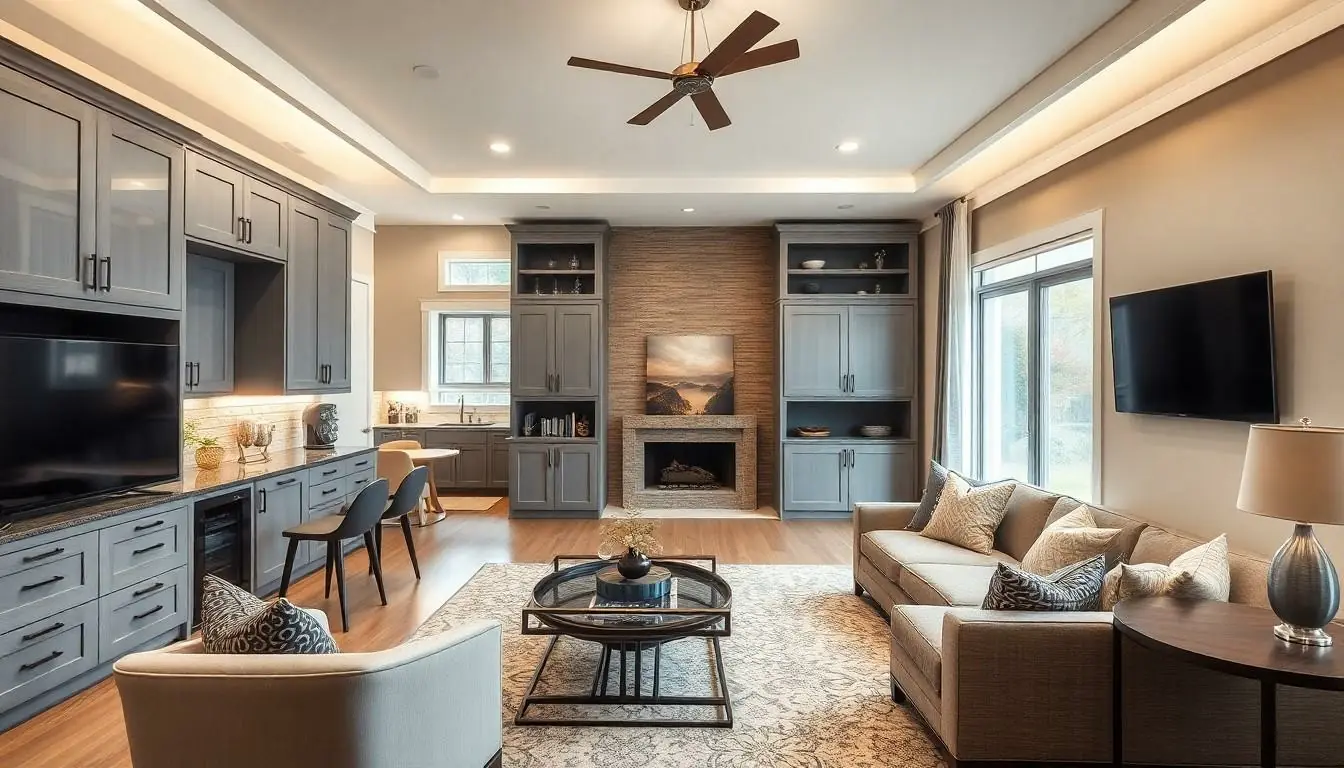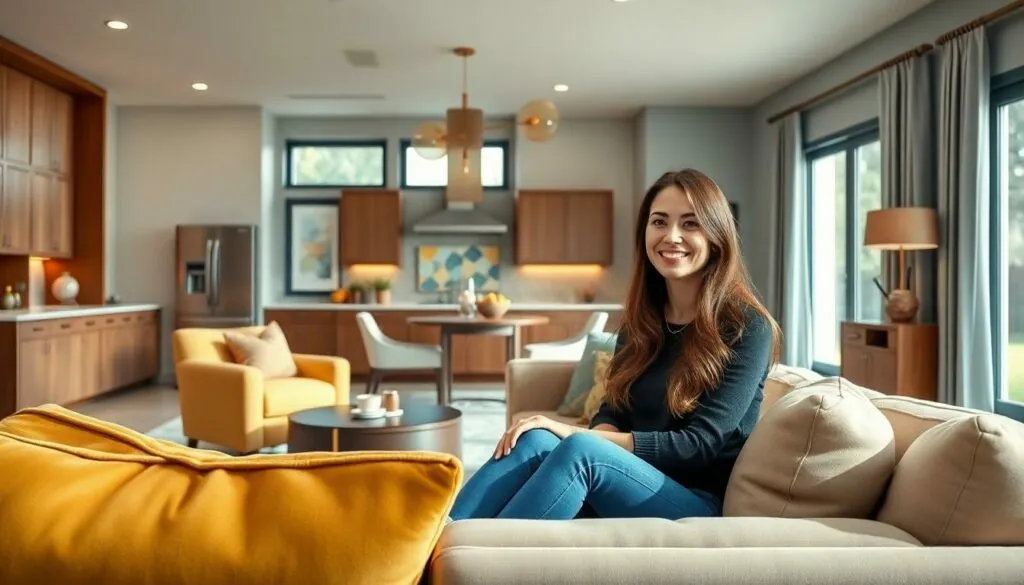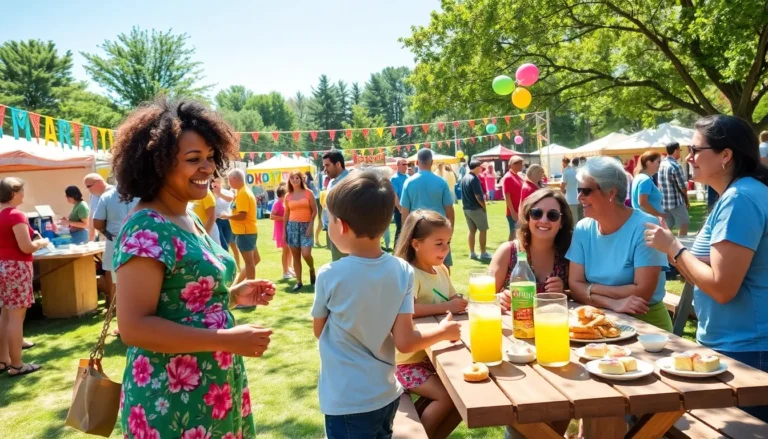Table of Contents
ToggleImagine stepping into a home that feels like it was plucked straight from your dreams—every corner, every texture, and every color speaking to your unique style. Custom home interiors do just that, transforming ordinary spaces into extraordinary sanctuaries. Whether it’s a cozy nook for reading or a vibrant living room for entertaining, these tailored designs reflect the personality and lifestyle of their inhabitants.
Overview of Custom Home Interiors
Custom home interiors define personalized living spaces that reflect individual tastes. Tailored designs enhance functionality and aesthetics, creating environments that cater to specific needs. Designs include elements such as custom cabinetry, unique lighting fixtures, and personalized color palettes.
Personalization plays a crucial role in achieving the desired atmosphere. Decor choices allow homeowners to showcase their interests and lifestyles. For instance, a dedicated home office may incorporate unique shelving tailored to an individual’s collection of books or art.
Details make a significant impact in custom interiors. Custom-built furniture often improves space optimization while adding character. Specific styles, like Scandinavian minimalism or Bohemian chic, resonate depending on the homeowner’s preferences.
Budget considerations also influence the customization process. Established budgets can guide decisions about materials and finishes. High-quality materials, while often pricier, enhance longevity and aesthetics.
Trends in custom home interiors evolve over time. Eco-friendly materials and sustainable design practices gain popularity, attracting environmentally-conscious homeowners. Integrating technology, such as smart home systems, further modernizes spaces.
Ultimately, custom home interiors create tailored environments fostering comfort and uniqueness. Their ability to adapt to personal tastes sets them apart from conventional designs. Different elements combine to produce harmonious spaces that truly reflect one’s individuality.
Benefits of Custom Home Interiors

Custom home interiors provide distinct advantages that elevate living spaces. These advantages include personalization that reflects individual tastes and enhanced functionality.
Personalization and Uniqueness
Personalization stands at the forefront of custom home interiors. Custom designs allow homeowners to showcase interests, lifestyles, and aesthetics, turning spaces into true reflections of their personalities. Tailored features like bespoke cabinetry and unique lighting add character. These personalized elements create inviting areas that resonate with their inhabitants, making ordinary spaces exceptional. With custom color palettes, homeowners can evoke specific moods, fostering comfort and connection. Therefore, each element becomes integral to the overall harmony of the home, distinguishing it from conventional designs.
Enhanced Functionality
Enhanced functionality transforms everyday living experiences. Custom home interiors adapt to the specific needs of each family member, optimizing space for maximum efficiency. Tailored solutions, such as built-in storage and multifunctional furniture, improve organization and accessibility. Home offices benefit from custom shelving that accommodates specific work requirements. Similarly, family rooms can incorporate features designed for entertainment, ensuring that each area serves its unique purpose effectively. These tailored designs promote ease of use and contribute to a more enjoyable living environment.
Popular Design Trends
Current design trends in custom home interiors reflect a blend of style, functionality, and sustainability. Homeowners increasingly seek features that not only beautify but also enhance the overall living experience.
Modern Aesthetics
Minimalism captures attention with clean lines and open spaces. Neutral color palettes dominate, creating serene atmospheres that allow for versatility in decor. Incorporating statement pieces, such as oversized art or unique furnishings, adds character. Natural light plays a crucial role, with large windows fostering a connection to the outdoors. Textures like wood and metal are used to create depth, enriching the visual appeal while maintaining simplicity.
Sustainable Materials
Eco-conscious choices gain popularity as homeowners embrace sustainability. Reclaimed wood, bamboo, and recycled materials appear in various applications, from flooring to cabinetry. Biodegradable and non-toxic finishes contribute to healthier living environments. Energy-efficient appliances also help reduce carbon footprints while enhancing modern functionality. Selecting sustainably sourced products becomes a priority, reflecting a commitment to both elegance and environmental responsibility.
Choosing the Right Custom Home Interior Designer
Selecting a custom home interior designer requires careful consideration. Look for designers with a strong portfolio. A diverse range of completed projects showcases versatility and creativity in their work. Personal recommendations also play an important role. Friends or family who have recently renovated can provide valuable insights and referrals.
Evaluate the designer’s communication style. Effective communication ensures that ideas are understood and expectations are aligned. Transparency about budgetary limits is crucial. Discussing budgets upfront helps avoid surprises later in the process.
Examine the designer’s specialization. Some professionals focus on traditional designs, while others excel in modern aesthetics. Identifying styles that resonate with personal taste simplifies the search for a compatible designer.
Consider the designer’s experience with custom features. Knowledge of bespoke cabinetry, unique lighting, and tailored color selections is essential. Each of these elements contributes significantly to creating a personalized space.
Visit completed projects or current job sites whenever possible. Observing a designer’s work firsthand provides insight into their craftsmanship and attention to detail. Engaging with past clients can also reveal their satisfaction levels and overall experience.
Review online testimonials and ratings. Positive feedback offers a good sense of a designer’s strengths and reliability. Social media platforms and websites often host client reviews that highlight specific successes and challenges.
Ultimately, choosing the right designer fuels the success of a custom home interior project. Prioritizing personal style, clear communication, and proven competence sets a solid foundation for transforming living spaces into unique expressions of personality.
Tips for Planning Your Custom Home Interiors
Begin with a clear vision of your desired style and functionality. Identify specific elements that resonate with personal tastes, such as color palettes or themes. Choose furniture that not only fits the space but also reflects individual character, ensuring it aligns with overall design goals.
Consider the lifestyle needs of those who will inhabit the space. For example, if frequent entertaining occurs, prioritize open layouts that facilitate social interaction. Determine essential features, like ample storage solutions and dedicated workspaces, which can enhance daily efficiency.
Select materials that combine durability with aesthetic appeal. High-quality finishes provide longevity while contributing to the overall vibe. Incorporate lighting fixtures that serve both decorative and practical purposes, enhancing the atmosphere in each room.
Evaluate and embrace current trends, like sustainable designs and eco-friendly materials. These choices not only appeal to environmental consciousness but also promote a contemporary feel. Popular options include reclaimed wood accents and energy-efficient appliances that blend beauty with responsibility.
Involve professionals during the planning process to refine ideas and concepts. Designers can offer insights into the latest innovations and practical solutions tailored to your vision. Seek advice from trusted sources who can recommend skilled experts with strong portfolios and proven results.
Schedule time to review completed projects and utilize online resources for inspiration. Create mood boards that capture desired aesthetics and practical features. Prioritize personal style throughout this journey to ensure the end result reflects individual personality and comfort.
Custom home interiors offer a unique opportunity to express individuality while enhancing functionality. By focusing on personalized designs homeowners can create inviting spaces that cater to their lifestyles and preferences. The integration of sustainable materials and smart technology reflects a growing trend towards eco-conscious living without sacrificing style.
Choosing the right designer is essential in this journey. A designer who understands personal vision and can navigate budget considerations will ensure a seamless transformation. As homeowners embark on this creative process they should embrace their unique tastes and prioritize elements that resonate with their vision.
Ultimately custom home interiors not only elevate the aesthetic appeal of a space but also foster a sense of comfort and belonging that truly makes a house feel like home.





